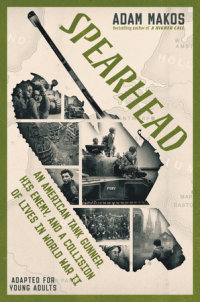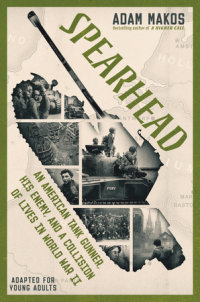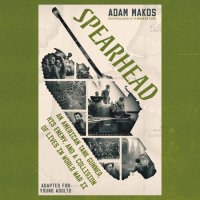Spearhead (Adapted for Young Adults)
Adapted for young adults from the New York Times bestseller, a riveting and true WWII story of a young man--an American tank gunner--who meets his destiny in an iconic armor duel and forges an enduring bond with his enemy.
Shut the hatches. It's time to roll out. You'll find yourself behind enemy lines with Clarence Smoyer and the 3rd Armored Division, the workhorse unit known as "Spearhead," the best in the tank armor ranks.
You'll feel as if you are right beside Clarence and his fellow crew members--all formerly strangers from across America who have now become family to each other. You will be jarred by enemy fire, and then explore the other side, stepping into the boots of German tanker soldier, Gustav Schaefer and his crew. You'll witness the heartbreaking tragedy, when an innocent young woman is caught in the crossfire. You'll see what happens when all of these lives collide, and realize how the aftershock still affects the survivors more than a half a century later. A riveting and true account of the perils of war as well as the prospect of forgiveness.
An Excerpt fromSpearhead (Adapted for Young Adults)
Chapter 1
The Gentle Giant
September 2, 1944
Occupied Belgium, during World War II
Twilight fell on a country crossroads. It was quiet except for the sound of insects buzzing in the surrounding fields. But there was something else, too. Metallic. The sound of hot engines ticking and pinging, cooling down after a long drive.
Silently and efficiently, American tank crewmen worked to rearm and refuel their Sherman tanks. They were trying to finish before the last streaks of color fled the sky.
Crouched behind his tank’s turret, Corporal Clarence Smoyer carefully passed 75mm shells to the loader inside. Even the slightest clang of these explosive projectiles could give them away to the enemy.
Clarence was twenty-one, tall and lean with a Roman nose and a sea of curly blond hair under a knit cap. His blue eyes were gentle but guarded. Despite his height, he was not a fighter. He’d never been in a fistfight. Back home in Pennsylvania he had hunted only once--for rabbit--and even that he did halfheartedly. Three weeks earlier he’d been promoted to gunner, second-in-command on the tank. It wasn’t a promotion he had wanted.
Beside Clarence’s tank, there were four more olive-drab tanks fanned out, “coiled,” in a half-moon formation. The platoon--a unit of 20 to 50 soldiers--was in place. Farther north, the city of Mons was just out of sight. To their left lay darkening fields of a forested ridge.
The Germans were out there. But how many were there? And when would they arrive? No one knew. It had been nearly three months since D-Day. Now Clarence and the men of the 3rd Armored Division were behind enemy lines.
The division was made up of 390 tanks at full strength. They had dispersed across the area, from the place where the enemy was situated all the way up to Mons.
Survival that night would come down to teamwork. The commanders at company headquarters had given Clarence’s platoon, 2nd Platoon, a simple but important mission: block the road, and guard it. Let nothing pass.
Clarence lowered himself through the commander’s hatch and into the turret. It was a tight fit for a six-foot man. He slipped into the gunner’s seat, leaning into his periscopic gunsight. This five-inch-wide relay of glass prisms and a 3x telescopic gunsight would be his windows to the world.
There would be no stepping out that night. It was too risky even to urinate outside. That was what they saved empty shell casings for.
Beneath Clarence’s feet was the main body of the tank, known as the hull, with its white enamel walls and three lights. In the bow at the front, the driver and bow gunner/assistant driver slid their seats backward. They’d sleep in the same seats where they’d ridden all day. The gun loader, meanwhile, stretched a sleeping bag on the turret floor. The tank smelled of oil, gunpowder, and a locker room, but the scent was familiar, even comforting. Ever since they’d come ashore, this M4A1 Sherman had been their home in “Easy Company” of the 32nd Armor Regiment, a unit of the 3rd Armored Division.
For eighteen days, the 3rd Armored had been leading the First Army. They had also led two other divisions in the breakout across northern France. Paris had been liberated, and the Germans were retreating. The 3rd Armored was earning its nickname: the Spearhead Division.
Then came new orders.
German armies had been spotted moving north, hightailing it out of France and heading for Belgium. On the way, they’d pass through Mons’s many crossroads. So the 3rd Armored turned on a dime and raced to catch them--107 miles in two days. They’d arrived just in time to lay an ambush.
Tonight, though, sleep would come quickly. The men were exhausted. The tank commander, Staff Sergeant Paul Faircloth, dropped down into the turret. He lowered the split hatch covers, leaving just a crack for air. He slumped into a seat behind Clarence. Paul Faircloth was also twenty-one, quiet and easygoing, with a sturdy build, black hair, and olive skin. Some assumed he was French or Italian, but he was half Cherokee and had grown up in Florida.
For two days Paul had been on his feet in the commander’s position. He was always the first person out of the tank to offer help or support.
“I’m taking your watch tonight,” Clarence said, figuring he’d give the guy a break. “I’ll do a double.”
The offer was generous, but Paul resisted--he could handle it.
Clarence persisted until Paul threw up his hands and finally swapped places with him to nab some shut-eye in the gunner’s seat.
Clarence snatched a Thompson submachine gun from the wall and took the commander’s position. For the next four hours, he kept watch for enemy foot soldiers. Everyone knew that German tankers didn’t like to fight at night.
Partway through Clarence’s watch, the darkness came alive with a mechanical rumbling. The moon was smothered by clouds. He couldn’t see a thing, but he could hear vehicles moving beyond the tree-lined ridge.
Start and stop. Start and stop.
The radio speaker hummed with static. No flares illuminated the sky. The Third Armored would later estimate that there were 30,000 enemy troops out there, mostly men of the German Army. Yet no order came to attack them.
That was because the enemy armies were losing precious fuel as they searched for a way around the maze of roadblocks the Americans had set up. Spearhead was content to let them wander. The enemy was desperately trying to reach the safety of the West Wall, also known as the Siegfried Line. This wall was a German defensive line stretched along the western border of the country.
If these 30,000 German troops could get there, they could bar the Allied troops’ way into Germany and prolong the war. And so, they had to be stopped, here, at Mons. Spearhead had a plan for that--but it could wait until daylight.
Around two a.m. a distant rumble arose. Clarence tracked the distinctive sounds of tank tracks. Vehicles were coming down the road in front of him. He knew his order: let nothing pass. But doubt was setting in. What if these tanks were American patrols? Whoever they were, he wasn’t about to pull the trigger on friendly forces.
One after the other, three tanks clanked past the Shermans. They kept going. Clarence exhaled slowly.
Then one of the tanks let off the gas. It began turning and squeaking, as if its tracks were in desperate need of oil. The sound was unmistakable. Only full-metal tracks sounded like that, while an American Sherman’s were padded with rubber.
The tanks were German.
Clarence didn’t move. The tank was behind him, then beside him. Clarence braced for a flash and the flames that would swallow him. He’d never even hear the Germans’ gun bark. He would just cease to exist.
The flash never came. Instead, a whisper shook Clarence from his paralysis. It was Paul. Without a word, Clarence slipped back into the gunner’s seat and Paul took over.
Clarence strapped on his tanker’s helmet. It had goggles attached and headphones sewn into leather earflaps. He clipped a throat microphone around his neck and plugged into the intercom.
On the other side of the turret, the loader sat up, wiping the sleep from his eyes.
Clarence mouthed the words German tank. The loader snapped wide-awake.
From his hatch, Paul tapped Clarence on the right shoulder, the signal to turn the turret to the right.
Clarence hesitated. The turret wasn’t exactly silent. What if the Germans heard it?
Paul tapped again.
Clarence obeyed, turning a handle. The turret whined. Gears cranked, and the gun swept the dark. When the gun was aligned, Paul stopped Clarence. Clarence pressed his eyes to his periscope. Everything below the skyline looked inky black.
Clarence told Paul that he couldn’t see a thing. What if they call in armored infantrymen--soldiers who fought on foot--to kill the tank with a bazooka? he suggested.
Paul couldn’t chance some jittery soldier blasting the wrong tank. “We’ll take care of him,” he said.
We’ll take care of him? Clarence was horrified. He had hardly used the gun in daylight. Now Paul wanted him to fire in pitch-darkness? At what? A sound? An enemy he couldn’t see?
He wished he could return to being a loader. On a tank crew, the loader was pretty much just along for the ride. That was the good life. A gentle giant, Clarence simply wanted to slip through the war without killing anyone. Or getting killed himself.
No time for that. By now, the German tank crew had probably realized they were surrounded.
“Gunner, ready?”
Panicked, Clarence tugged on Paul’s pant leg. Paul sank into the turret, exasperated. Clarence rattled off his doubts. What if he missed? What if he hit their own guys?
Paul’s voice calmed him: “Somebody has to take the shot.”
As if the Germans had been listening, they suddenly cut their power. The hot engine hissed, then went silent.
Clarence felt a wave of relief, which quickly faded. His indecision had cost them whatever advantage they’d had. And against a German tank, they’d need every advantage they could get. Especially if they were facing a Panther, the tank of nightmares. Rumor had it that a Panther could shoot through one Sherman and into a second.
That July, the U.S. Army had placed several captured Panthers in a field in Normandy. Men blasted away at them with the same kind of 75mm gun that was in Clarence’s Sherman. They’d busted up the German tank’s flanks and rear, but not a single shot managed to penetrate the Panther’s frontal armor.
Clarence checked his luminescent watch, knowing the Germans were probably doing the same. The countdown had begun.
Three a.m. became four a.m.
Clarence and Paul passed a canteen of cold coffee back and forth. They had always joked that they were a family locked in a sardine can. And like a family, they didn’t always see eye to eye. Unlike Paul, who was always running off to help someone outside the tank, all Clarence cared about was his own family on the inside--him and his crew.
This had been his way since childhood.
Growing up in industrial Lehighton, Pennsylvania, Clarence lived in a row house by the river, with walls so flimsy he could hear the neighbors. His parents were usually out working to keep the family afloat. His father did manual labor for the Civilian Conservation Corps public works program, and his mother was a housekeeper.
With the family’s survival at stake, Clarence had been determined to contribute. When other kids played sports or did homework, twelve-year-old Clarence stacked a ballpark vendor’s box with candy bars and went selling door-to-door throughout Lehighton. Just a boy, he had vowed: I’ve got to take care of my family because no one is going to take care of us.
Now, there he was in the Sherman, trying to take care of his own. Clarence checked his periscope. He kept his eyes glued to the glass until a blocky shape appeared about fifty yards away.
“I see it,” he whispered.
Hurry, Paul urged. If they could see the enemy, the enemy could see them.
Clarence settled the crosshairs on his periscope, known as the reticle, on the dark shape that looked like a tank. He was ready. The trigger was a button on the footrest. His boot hovered over it.
“Fire,” Paul said.
Clarence’s foot stamped down.
Outside, a massive flash leaped from the Sherman’s barrel. For a moment, it illuminated the olive-drab American tank and the sandy-yellow German one.
Inside the turret, smoke hung thick in the air. Clarence’s ears throbbed and his eyes stung. Again, he hovered his foot over the trigger.
“Nothing’s moving,” Paul said from above.
The intercom came alive with voices of relief. Clarence moved his foot away from the trigger.
Paul radioed the platoon; the job was done.
Through his periscope, Clarence watched the dark clouds fade, revealing the boxy armor and the 11-foot, 8-inch-long gun of a Panzer IV tank.
Known by the Americans as the Mark IV, the design was older, and it had been the Germans’ most prevalent tank until the Panther began taking over. But though it was no Panther, the Mark IV was still lethal. Its 75mm gun packed 25 percent more punch than Clarence’s. Clarence had nearly placed his shot right on it.
Clarence envisioned a tank full of moaning, bleeding men and hoped the crew had slipped out in the night. He had no love for the Germans, but he hated the idea of killing any human being. He wasn’t about to look inside his first tank kill.
“I’ll go.” Paul unplugged his helmet.
Clarence tried to dissuade him. It wasn’t worth looking inside and getting his head blown off by a German.
Paul brushed away the concerns and radioed the platoon to hold their fire.
Through his periscope, Clarence watched Paul climb the Mark IV’s hull and creep toward the turret with his Thompson at the ready. Carefully, Paul opened the commander’s hatch and aimed the Thompson inside.
Nothing happened.
He leaned forward and took a long look, then shouldered his gun.
Paul sealed the hatch shut.
Chapter 2
Baptism
That same morning, September 3, 1944
Mons, Belgium
After the tense standoff of the previous night, the American tanks were on the move.
With the rising sun at their backs, Shermans flooded across the Mons countryside. The goal was to spread the division out so they could cover as much ground as possible, squeezing the enemy out. Every country lane and every farmer’s path had to be roadblocked.
With his goggles lowered, Paul rode above his open hatch. His jacket flapped in the wind. The machine around him seemed alive. Everything vibrated: helmets hanging from the turret, a machine gun on a mount, spare wheels tied down wherever they would fit. The tank seemed to clear its throat with each gear change. It was run by an engine that had to be cranked awake by hand.
This Sherman was a “75,” owing to its 75mm gun, but to Clarence’s crew it had a name. Eagle. Someone had even painted an eagle head on each side of the hull. Every tank’s name in Easy Company began with the letter E.
Paul raised his field glasses to his eyes and studied the terrain ahead. The tank was bound for the tree-lined ridge where the commotion had been that previous night.
One by one, the neighboring Shermans vanished from sight. They plunged into patches of woods or slipped around the edges of fields and set their guns toward the enemy. Every tree, every shadow now seemed laced with danger.
Paul’s orders were to set a roadblock right where the German tank had been the day before. He had assured Clarence that the German crew had escaped the Mark IV alive. Paul knew Clarence didn’t want to harm anyone. Clarence had a suspicion that his friend was just trying to protect him. Paul had done it before.



